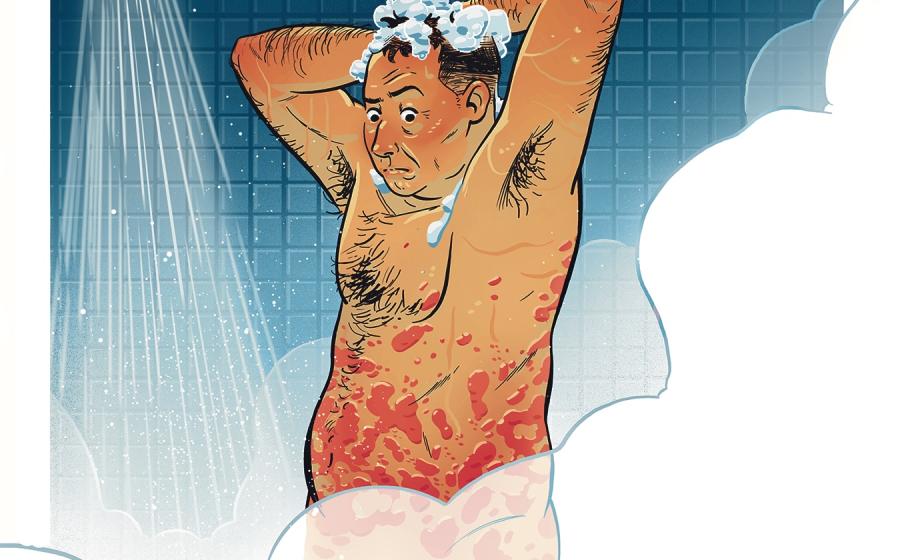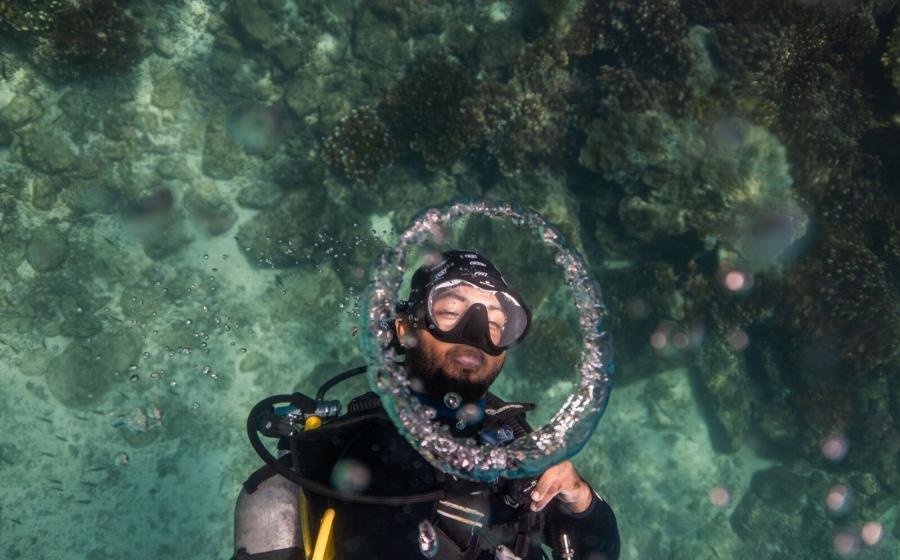Ask an Expert: Should New Divers Learn Lifesaving?

Scuba Diver CPR
It's better to wait for Rescue Diver training after you’ve got confidence in basic skills
By Tom Forbes
As to whether scuba certification — meaning basic open-water training — should necessarily include CPR and Basic Life Support training, I vote no. I would put it in the “nice to have but can wait till you take Rescue” category.
There’s a lot to cover in basic OW, and you need to learn it well since it’s all life support — all the rules are “written in blood,” based on lessons learned from accidents, some of which are fatal. Diving is largely safe if you follow the rules, and unsafe if you don’t. OW is about learning those rules and attaining a C-card, essentially a learner’s permit to go out and learn diving by doing it. We do it by modeling our behavior after the better divers we buddy with, watch or listen to. This is how we become safer divers who can manage basic hazards as the coping process slowly becomes second nature: You have to learn to skate before you can tend goal.
OW classes are intended to produce “potentially safe” beginners, who can handle routine, nonchallenging dives well enough to learn better diving by — yes — diving. This can be the school of hard knocks, but it works as long as the knocks aren’t too hard and we pick good buddies, divemasters, and boat captains.
The emphasis in basic training is on certifying divers who are self-sufficient and won’t likely become a problem that requires serious intervention by others, not on turning out divers ready to assist another diver medically. That’s how we end up diving beyond our capabilities, since all rescues involve some stress and task overload. I wouldn’t encourage this in new divers. If they already hold a CPR/ First Aid card, then all the better, but they don’t yet have the diving fundamentals necessary to use these skills in the water. Adding first-responder medical training as a requirement — rather than just a “nice to have” extra — will further overload the classroom and pool curriculum, and steer new divers toward being first responders when they aren’t ready to fill those booties.
Better to wait for Rescue Diver for this, after you’ve got about 50 dives under your weight belt and the consequent buoyancy and air-consumption control, serenity, and confidence that comes only with experience. Then you’ll have the dive foundation on which you can build a medical-response room in your otherwise sturdy diving house.
Basic, hands-only life support is so easy to learn, there’s no reason not to include it
By Doc Vikingo
Each year, more than 380,000 people suffer cardiac arrest outside of the hospital in the United States. Of those, fewer than 6 percent survive, according to the American Heart Association. If the brain is deprived of oxygen for just four minutes, permanent brain damage can occur — CPR can restore some cerebral blood flow, and also can help keep other organ systems viable, even if ultimately only for transplant purposes.
Now, I’ll readily admit that hands-only CPR — as well as traditional CPR, which involves alternating periods of chest compressions and breathing into the victim’s mouth — and even relatively sophisticated electrical devices like automated external defibrillators do not work miracles. In fact, some quality research indicates that the increases in the survival of sudden cardiac arrest following the application of CPR, even when it’s given within hospital settings, are quite modest. Nevertheless, when it’s performed properly, CPR can double a person’s odds of surviving. And, if it’s you who saves that life with CPR, I can guarantee you that it’s a very special accomplishment and feeling.
While there might be some legitimate concerns — such as the amount of time that such a component adds to the training regimen, and the possibility of it interfering with the mastery of the basic dive skills that a beginning scuba-certification candidate must master — I find these to be minor. The total time to complete an American Heart Association-approved Heartsaver CPR class is three to three-and-a-half hours. Given a typical PADI OW scuba-certification class’ duration of three to four days, such CPR training would add only about an hour or less to each training day. Alternatively, in these short classes, hands-only CPR could be made a prerequisite. Cert classes that provide several weeks to complete book and pool work — which I believe provide a superior learning experience, and produce more competent and confident divers than do shorter courses — would have only a half hour or less added to the daily training regimen. In semester-long classes, such as those offered at community colleges, the time demands required for mastery of this lifesaving skill become downright trivial.
Hands-only CPR is extremely simple. So simple, in fact, that it could be argued that trainees who cannot easily master it are not ready for the complexities and demands of diving.
To read more lively debates concerning scuba diving, visit the Ask an Expert section of our website.

It's better to wait for Rescue Diver training after you’ve got confidence in basic skills
By Tom Forbes
As to whether scuba certification — meaning basic open-water training — should necessarily include CPR and Basic Life Support training, I vote no. I would put it in the “nice to have but can wait till you take Rescue” category.
There’s a lot to cover in basic OW, and you need to learn it well since it’s all life support — all the rules are “written in blood,” based on lessons learned from accidents, some of which are fatal. Diving is largely safe if you follow the rules, and unsafe if you don’t. OW is about learning those rules and attaining a C-card, essentially a learner’s permit to go out and learn diving by doing it. We do it by modeling our behavior after the better divers we buddy with, watch or listen to. This is how we become safer divers who can manage basic hazards as the coping process slowly becomes second nature: You have to learn to skate before you can tend goal.
OW classes are intended to produce “potentially safe” beginners, who can handle routine, nonchallenging dives well enough to learn better diving by — yes — diving. This can be the school of hard knocks, but it works as long as the knocks aren’t too hard and we pick good buddies, divemasters, and boat captains.
The emphasis in basic training is on certifying divers who are self-sufficient and won’t likely become a problem that requires serious intervention by others, not on turning out divers ready to assist another diver medically. That’s how we end up diving beyond our capabilities, since all rescues involve some stress and task overload. I wouldn’t encourage this in new divers. If they already hold a CPR/ First Aid card, then all the better, but they don’t yet have the diving fundamentals necessary to use these skills in the water. Adding first-responder medical training as a requirement — rather than just a “nice to have” extra — will further overload the classroom and pool curriculum, and steer new divers toward being first responders when they aren’t ready to fill those booties.
Better to wait for Rescue Diver for this, after you’ve got about 50 dives under your weight belt and the consequent buoyancy and air-consumption control, serenity, and confidence that comes only with experience. Then you’ll have the dive foundation on which you can build a medical-response room in your otherwise sturdy diving house.
Basic, hands-only life support is so easy to learn, there’s no reason not to include it
By Doc Vikingo
Each year, more than 380,000 people suffer cardiac arrest outside of the hospital in the United States. Of those, fewer than 6 percent survive, according to the American Heart Association. If the brain is deprived of oxygen for just four minutes, permanent brain damage can occur — CPR can restore some cerebral blood flow, and also can help keep other organ systems viable, even if ultimately only for transplant purposes.
Now, I’ll readily admit that hands-only CPR — as well as traditional CPR, which involves alternating periods of chest compressions and breathing into the victim’s mouth — and even relatively sophisticated electrical devices like automated external defibrillators do not work miracles. In fact, some quality research indicates that the increases in the survival of sudden cardiac arrest following the application of CPR, even when it’s given within hospital settings, are quite modest. Nevertheless, when it’s performed properly, CPR can double a person’s odds of surviving. And, if it’s you who saves that life with CPR, I can guarantee you that it’s a very special accomplishment and feeling.
While there might be some legitimate concerns — such as the amount of time that such a component adds to the training regimen, and the possibility of it interfering with the mastery of the basic dive skills that a beginning scuba-certification candidate must master — I find these to be minor. The total time to complete an American Heart Association-approved Heartsaver CPR class is three to three-and-a-half hours. Given a typical PADI OW scuba-certification class’ duration of three to four days, such CPR training would add only about an hour or less to each training day. Alternatively, in these short classes, hands-only CPR could be made a prerequisite. Cert classes that provide several weeks to complete book and pool work — which I believe provide a superior learning experience, and produce more competent and confident divers than do shorter courses — would have only a half hour or less added to the daily training regimen. In semester-long classes, such as those offered at community colleges, the time demands required for mastery of this lifesaving skill become downright trivial.
Hands-only CPR is extremely simple. So simple, in fact, that it could be argued that trainees who cannot easily master it are not ready for the complexities and demands of diving.
To read more lively debates concerning scuba diving, visit the Ask an Expert section of our website.










